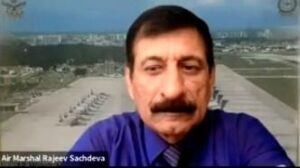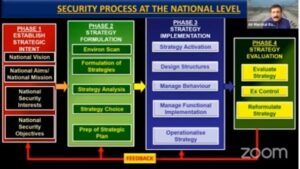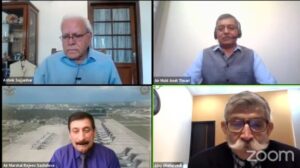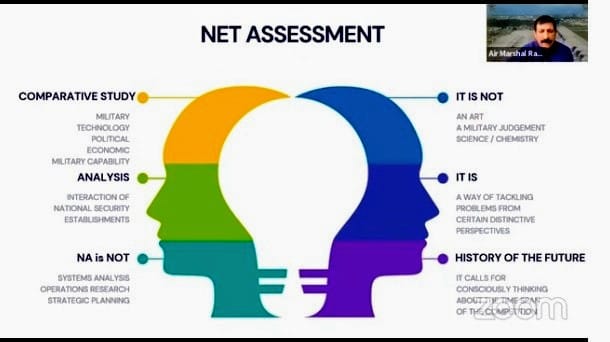Net Assessment of the Comprehensive National Power, Hot Wash by Team STRIVE
![]()
Introduction
Strategic planning entails taking a comprehensive view of all those factors which have a bearing on the desired outcome over a period of time. In this connection it is important to organize this kind of analysis in relative terms with an adversary to arrive at the useful outcome. This technique of assessment was developed by an US foreign policy analyst Andrew Marshall post World War-II in the decade of sentries of the last century for the US Army to provide strategic evaluations on the nuclear war issues. This kind of assessment is highly relevant in India’s context also, to work out an assessment of the Comprehensive National Power (CNP) related to Pakistan and China to evolve a National Security Strategy (NSS) to deal with them.
A webinar on the above titled subject was organized by the Team STRIVE on 05 Nov 2022. The Keynote address was delivered by Air Marshal (Dr) Rajeev Sachdeva, AVSM (Retd) and other speaker for the event was Sri Ashok Sajjanhar, a former diplomat and now a prolific author and speaker on international affairs. Air Marshal Amit Tewari, PVSM, AVSM, VM (Retd) an esteemed member the Team STRIVE anchored the event.
Air Marshal Amit Tewari, PVSM, AVSM, VM (Retd) an esteemed member the Team STRIVE anchored the event.
The format followed entailed; an introduction to the two topics by the Anchor, followed by the prestation by the Air Marshal (Dr) Rajeev Sachdeva, talk by Ambassador Ashok Sajjanhar, Q&A session by the Anchor and finally closing remarks by Maj Gen AK Chaturvedi, Vice Chairman, STRIVE.
Topics which the Two speakers spoke on, were as follows: –
- Air Marshal (Dr) Rajeev Sachdeva, AVSM (Retd)– Net Assessment of India’s Comprehensive National Power.
- Ambassador Ashok Sajjanhar (Retd) – Evolution of India’s Foreign Policy and the Path it should follow to Future to Enhance India’s Comprehensive national Power.
Issues which were Highlighted by the Speakers, during their Respective Presentation/ Talks
 Air Marshal (Dr) Rajeev Sachdeva
Air Marshal (Dr) Rajeev Sachdeva
- Net Assessment is meant work out the ‘National Security’ in quantified terms. There are 93 departments whose inputs are taken into account. That makes it is a systematic method of analysis that fulfils the need for an indirect decision support system that provides a major input to the strategic planning/management system. It is a process of appraising two or more competitors as objectively as humanly possible to work out the relative power. In this process an analyst is guided to examine factors normally overlooked. Factors that change the environment should be taken into account. It is also important that a system of feed back should be part of the process because that helps in improving the quality of analysis continuously.
- It also takes into account asymmetries that exist among competitors and the ability of a competitor to achieve its objectives in various conflicts are examples of some of these factors.Its relevance in Indian context is assuming greater importance as strategic planning had always been a weakness of the Indian decision making process.
- The speaker introduced an important term, ‘History of Future’ to highlight the importance of ‘Scenario Building’ to bring out relevance of various factors which are likely to impinge on working out the Comprehensive National Power (CNP) .
- It came out clearly that the existing social milieu and likely changes over the period for which the assessment is being done has to be factored in the analysis. Likewise societal values also need to be factored in the analysis.
- Economy is yet another very important factor in the analysis to work out the CNP. However in this connection it is important to realise that the prosperity without equity is likely to result into problems therefore GDP/ growth rate of the GDP alone is likely to give misleading results.
 Strategic formulation is critical for arriving at the response strategy and for that defining national interests and related objectives in terms of short, medium and long term need to be evolved. Simultaneously contributors of these need to be identified. To arrive at an objective outcome following analyses need to be done: –
Strategic formulation is critical for arriving at the response strategy and for that defining national interests and related objectives in terms of short, medium and long term need to be evolved. Simultaneously contributors of these need to be identified. To arrive at an objective outcome following analyses need to be done: –
- Geo Strategic Environmental Scan.
- Base- Means- Capacity (BMC) analysis.
- Strength-Weakness-Opportunity-Threat (SWOT) analysis.
- Scenario Building.
- After the due analysis strategic options are worked out which help in preparing NSS.
- The BMC Analysis and SWOT Analysis need to be done continuously. Scenario Building entails prediction of future with a view to reduce uncertainty. For this following scenarios are considered-
- Possible.
- Plausible
- Probable.
- Preferable.
- This kind of Scenario building helps in developing ‘Core strategy’, ‘Basic Strategy’ and ‘Wild card’ option. After that ‘Risk Analysis’ and ‘Risk Mitigation’ of the Strategy should be done. This sequential analysis helps in developing a Viable ‘National Security Policy’. Risk Analysis and Risk Mitigation plan entail threat assessment with a view to get answers to following: –
-
- Why?
- With what?
- How much?
- When?
- Who?
- It is reassuring to note that India has also been doing ‘Net Assessment’ on a continuous basis. Speech of Dr S Jaishankar on June 3 at the GLOBSEC-2022 Forum in Bratislava, Slovakia, is a clear indication of that.
 Ambassador Ashok Sajjanhar
Ambassador Ashok Sajjanhar
- There are four pillars of foreign policy-
- There are no permanent friends – only interests are permanent.
- Foreign policy reflects domestic strengths and issues.
- Foremost tasks for transformation of India to a strong and responsible nation are to strengthen; economy; democracy; judiciary and plurality.
- Foreign policy has to be dynamic to respond to geopolitical developments effectively.
- Current state of India- the GDP is growing and increasingly India is becoming indispensable to many of the happenings in the world. Case in point the current Russo- Ukrainian conflict, where world is looking forward to Indian initiative to bring the waring countries to negotiating table.
- Indian policy of ‘non-Alignment’ during the cold war period has now transformed into a policy of Strategic Autonomy. Indian policy of abstention in Ukraine conflict is a manifestation of the same. Indian Foreign Policy is now quite balanced, matured and yet bold. Success of Indian Foreign policy can be gauged from the mere fact that the PM’s message during the talks with President of the Russian Federation, whom he met on the side lines of the 22nd meeting of the Shanghai Cooperation Organization in Uzbekistan’s Samarkand in Sep 2022 that “today’s era is not of war”, was appreciated by most of the World leaders and today the world is looking up to India to help to resolve the ongoing conflict between Russia and Ukraine.
- Besides ‘Neighbours First’ India is also following a ‘Act East (which earlier was Look East) policy to have a meaningful engagement with ASEAN Countries.
- India’s engagement with the USA has been steadily growing. Over a period of time the USA has emerged as the most consequential partners. Some of the high points of this growing engagement has been as follows: –
- 2005- signing of the ‘Framework Agreement’.
- 2008-The 123 Agreement between India and US was finally operationalized between the two countries after the deal was signed. In another development during the same year, India with the help of US managed to get a ‘Clean Waiver’ by Nuclear Supplier Group (NSG) from its existing rules, which forbid nuclear trade with a country which has not signed the Nuclear Non-Proliferation Treaty (NPT)- this helped India in getting the Uranium supply resumed.
- A new pragmatism has come into foreign policy since 2014. A policy decision has been taken to ensure following: –
- Strategic alignments.
- Focused interests with a view to get support from every state.
- During the period 2016-19, India has gone to improve relations with Japan and Australia under the JAI initiative and it has been a great success. Revitalisation of QUAD is adding value to Indian interests in Asia Pacific Region. Similarly India attempted to improve relations with Russia and China under the initiative of RIC, which got a setback post 2020 India China Standoff. As far as dealing with neighbours is concerned India is following the policy of ‘Neighbourhood First’. This policy is successful but oddity of it is relations with Pakistan which continue to be hostile. In fact surprisingly relations with Afghanistan, despite regime change there in 2021, are not as frosty as one had expected post-Taliban takeover. The Indian Foreign policy’s new approach is quite visible in India’s response to Pakistan and China, wherein India has advocated peace but if the adversaries follow the line of hostility then it cannot be business as usual, and India would not hesitate to give befitting response..
- However, during COVID the help in what was described as Vaccine diplomacy Indian approach was appreciated by a large number of countries of the world. Similarly, helping Indian diaspora in many of the moments of crises have projected the image of India as a country which cares for its people. In fact new approach is giving clarity to workout CNP.
- The challenges are also there for the diplomatic corps to tackle many of the issues which face India. The biggest challenge is how to tackle China. Measures which need to be taken are; need to strengthen economy; scale up domestic manufacturing, keep up the tempo to improve infrastructure especially border infrastructure, continue the exercise of rebalancing with the powers of the World as well as maintain balance between internal and external challenges. While relationship with US and other western powers is improving but Russia is equally Important for India and the two relationships cannot be mutually exclusive.

Conclusion
Overall, it was a good webinar which helped the audience to understand the nuance of the technique of Net Assessment to calculate the CNP and its application into strategic planning. Webinar also helped the audience to understand the basic premises on which India’s foreign policy is based and how with the current approach India is able to maintain its Strategic autonomy and follow a policy which helps India in realizing her National interests.
Further Reading
The above-mentioned webinar was conducted by Team ‘STRIVE’ on 05 Nov 22. Air Mshl (Dr) R Sachdeva very succinctly brought out the importance and nuances of assessing the ‘Comprehensive National Power’. With that foundational knowledge, interested members who are keen to further dwell into the topic, may visit ⇓
https://power.lowyinstitute.org/compare/
The site among other things, compares the Comprehensive national power of two countries. The site is limited to Asian countries. The comparison of China’s and India’s comprehensive national power is attached as an example.

STRIVE Webinar 18 on “Net Assessment of India’s Comprehensive National Power”. Must watch…
You Tube link 👉🏽 https://youtu.be/9zg9gEVyBd4
Compiled & Edited By –  Maj Gen AK Chaturvedi, AVSM, VSM (Retd) is a retired Indian Army General Officer who has served in Jammu & Kashmir, NE, Andman Nikobar on various appointments at Command and Army HQs. He is Vice Chairman of Think Tank, “STRIVE”, after retirement is pursuing his favorite hobby of writing for newspapers, journals, and think tanks.
Maj Gen AK Chaturvedi, AVSM, VSM (Retd) is a retired Indian Army General Officer who has served in Jammu & Kashmir, NE, Andman Nikobar on various appointments at Command and Army HQs. He is Vice Chairman of Think Tank, “STRIVE”, after retirement is pursuing his favorite hobby of writing for newspapers, journals, and think tanks.
Disclaimer: The views expressed are those of the author and do not necessarily represent the views of the organisation that he belongs to or of the STRIVE.






Net Assessment is a technique appropriate to assess the relative category of two adversary based on a comprehensive analysis of all possible factors. This technique can also be used for building future scenarios also. That is why it can also be used by organisations other than Armed Forces. That makes this technique a very important analytical tool.